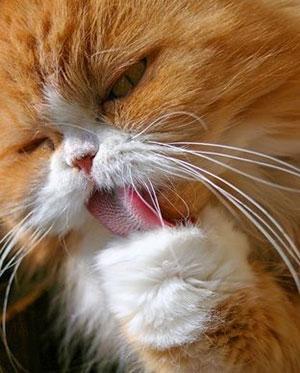This content is archived from the Feline Nutrition Foundation
Answers: Your Cat's Acid Stomach
- Updated: Saturday, June 01, 2019 03:08 PM
- Published: Saturday, May 03, 2014 07:43 PM
- Written by Lyn Thomson, BVSc DipHom
 I am new to feeding raw cat food. I read that one of the things that makes cats different from many other mammals is their highly-acidic digestive systems. Why is having an acidic stomach important for cats? How does it help them?
I am new to feeding raw cat food. I read that one of the things that makes cats different from many other mammals is their highly-acidic digestive systems. Why is having an acidic stomach important for cats? How does it help them?
Cats need a highly-acidic stomach in order to properly digest their food. Unfortunately, the carbohydrates found in many processed commercial cat foods make the stomach less acidic. Meat protein stimulates acidity by triggering the production of hydrochloric acid in acid-secreting cells. A complex cascade takes place when a cat ingests food. Put simply, 80 percent of the gastric juices secreted are a direct result of chemoreceptors in the stomach detecting the presence of meat-based proteins. This keeps it at a very low pH of around 1-2. A low pH means high acidity. This low pH is important because digestive enzymes work best in an acidic environment. That acidity also sterilizes ingested pathogens, both bacterial and fungal.
When a cat swallows a commercial pet food that is high in carbohydrate and plant protein and low in meat protein, acid-secreting cells in the stomach are not stimulated to produce much hydrochloric acid. The pH rises to around 4-5. That high pH means low acidity. The acidic chyme leaving the stomach is the trigger for the next stage of digestion in the small intestine. The acidity encourages the flow of bile and pancreatic enzymes necessary to continue the digestive process. If the contents are not sitting at a pH of around 1-2, digestion is impaired throughout the rest of the digestive tract as well.
 What does this mean for cats as obligate carnivores? A diet high in carbohydrates inhibits stomach acidity. Raw food for cats, whether whole meats or ground, requires a highly-acidic stomach for digestion. Cats should not be fed a combination of processed and raw foods, as they can experience a range of problems:
What does this mean for cats as obligate carnivores? A diet high in carbohydrates inhibits stomach acidity. Raw food for cats, whether whole meats or ground, requires a highly-acidic stomach for digestion. Cats should not be fed a combination of processed and raw foods, as they can experience a range of problems:
- They will struggle to properly digest their foods.
- They may become constipated with undigested bone spicules impacted in the rectum, which can be painful.
- Raw meaty bones can sit for long periods in the stomach, which may lead to vomiting bone, or worse still, an obstruction.
- They may experience a gastro-intestinal upset when the bacterial load of the ingested food runs riot in the alkaline environment. Gastric acidity is needed to sterilise ingested pathogens. Processed pet foods can be contaminated with salmonella and mycotoxins.¹ The gastric acidity is a first line of defence, making cats with reduced acidity vulnerable.
Additional Reading
Answers: Cat Urine Ph, Why It Matters
Answers: The Stomach Contents of Prey
If you are transitioning your kitty to a raw cat food diet, you may be feeding a combination for a short period of time. It is important to observe your cat carefully during this time and move as quickly as possible to a fully raw diet, to lessen the risk of any adverse effects.
Note: Feline Nutrition provides feline health and nutrition information as a public service. Diagnosis and treatment of specific conditions should always be in consultation with your own veterinarian. Feline Nutrition disclaims all warranties and liability related to the veterinary advice and information provided on this site.
Dr. Lyn Thomson trained at the University of Bristol in England and is studying with the Australasian College of Nutritional and Environmental Medicine. A dedicated and experienced advocate of bio-appropriate nutrition, Lyn practices in Auckland, New Zealand. HerRaw Essentials stores have grown to seven retail locations, providing a variety of raw diet products for cats and dogs.
1. "Mycotoxins – The Hidden Danger in Feed," VetReport.net, Sept 19, 2013.




